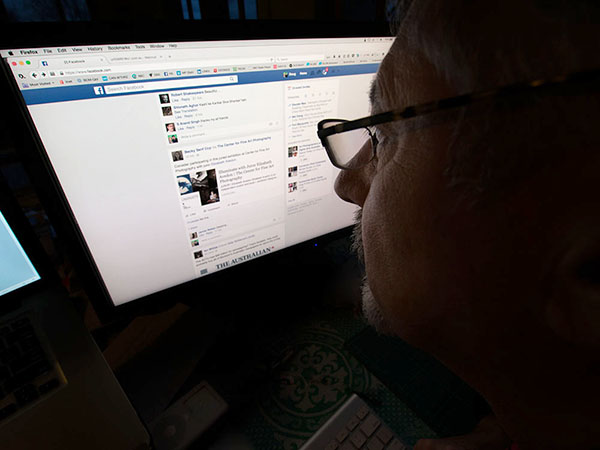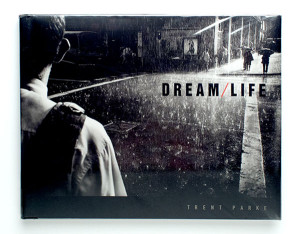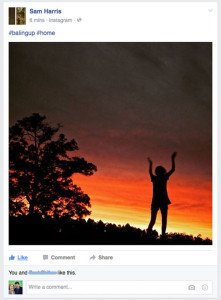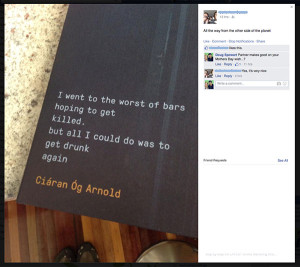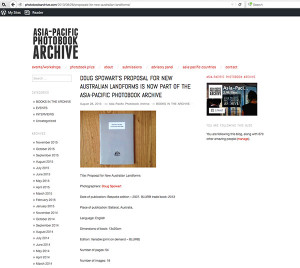Doug Spowart has been extensively involved in creative media areas for over 40 years. His research investigates the contemporary photobook and has published and presented papers on the topic at national and international forums.
He was the 2014 Siganto Foundation Artists’ Book Research Fellow at the State Library of Queensland Australia where his research investigated the intersection between the photograph and the artists’ book.
The photo-book is at the core of a self-publishing revolution. Now, every photographer wants to make their own books, finding inspiration in the latest photo-books and informed by the movers and shakers of the discipline. As a result, there is an emerging, heightened anxiety for personal connection within the pulse of this worldwide phenomenon. Social media is the communication vehicle of choice, and everyday, participants in the photo-book network frenetically seek updates, reviews, new releases, and posts about their books as well as the latest gossip through such channels. The consequent anxiety is palpable. This paper discusses social media as a powerful tool for communication and community building in the Indie publishing movement of photo-books.
SOME BACKGROUND
I doubt that Henry Fox Talbot or Anna Atkins realized in the 1840s what an impact their first use of photographs in books would have within the world of publishing. The publishing and bookselling paradigm that they would have been familiar with is now disrupted by digital technologies and a self-publishing revolution. All photographers desire their own books, and they now possess the technological means to make and distribute them.
Photographers were originally contributors to book-making projects by supplying the images, while others—designers, editors, copywriters, printers, and publishers—saw the project through to completion. Today, the independent self-publisher, who often works in isolation, needs the collective knowledge and skills of the old publishing team. To be informed, these photo-book makers need inspiration from the trendsetters of the discipline, they need to be part of what is happening now, and they need to keep up to date with future trends and opportunities. To achieve this, a contemporary photo-book community has emerged, and while it does have a local and vibrant face-to-face base, its dynamic energy exists in an international space that is supported by the connectivity of the Internet.
SOCIAL MEDIA & PHOTO-BOOK ANXIETY
Social media (SM) is the communication vehicle of choice for participants in this photo-book community. The 24-hour active cycle of SM engenders a heightened anxiety in participants who demand constant and direct personal connection with the pulse of this worldwide phenomenon. Many are driven to frenetically seek updates, reviews, new releases, and posts about their books as well as the latest gossip made available through these SM channels. Facebook, blogs, websites, and online production and purchasing services are the powerful tools for this necessary communication as well as for building an expanding community of makers, buyers, collectors, commentators, and critics of the burgeoning indie publishing photo-books movement. The anxiety surrounding this pervasive activity is palpable and anticipation of the next big thing keeps things surging through SM networks.
From observations and personal experience, I propose a term for the obsessive behaviors of participants in photo-book SM, “Photobook Anxiety”, and I further suggest the faux-scientific clinical term, “PBX”.
What then are the signs of those who suffer from this PBX malady? What phrases would a seriously afflicted PBX sufferer use to describe their symptoms?
Wishing I could be there…
There are so many events that happen worldwide it is impossible to get to all of them, let alone one. In a Facebook newsfeed the frustrated respondent posted: ‘Oh I would freaking kill to be there…’[i]
- A sampling of the 2015 calendar included these events:
- Photobook Melbourne February
- Art Book Melbourne – May
- Photo London – May
- Auckland Festival of Photography (Photobook Symposium) – May
- Kassel Foto Book Festival – June
- Obscura Festival of Photography (Photobook Day) – August
- Perimeter Books, Melbourne, book sale
- Book Case Study in the Netherlands – September
- Aperture at Photo Paris – November
2. I should have bought a copy of…
Trent Parke’s Dream Life, arguably Australia’s greatest photo-book, is an excellent example of a rare and out-of-print photo-book. Originally selling for around $60 in 2001, it is now is impossible to get a copy for prices less that thirty times that amount. The lowest price listed on Amazon recently was $1,998 USD.[ii] Recently, Abebooks listed one for $1,257 USD.[iii] The rare News Limited cover, a limited edition of 500 copies, was also listed on Abebooks at $2,500 USD.
3. I must be aware of limited editions and pre-ordering opportunities
Adding to PBX is the trend, particularly among American photo-book suppliers like Photo-Eye, to advertise limited supplies of signed books which can be “pre-ordered” with specific cut-off times and dates. However, even these can be sold-out before you hear about the offer being available, as was the case with Sally Mann’s Hold Still in 2015.[iv] Many of the self-published photo-book and ephemeral photo-zine editions may only be 50–200 copies further adding to the necessity to be aware of these books being available and getting an order in quickly. In mid-2015, Australian Bloom Publishing offered little badges with the text “Print Forever” as white text on a black background. These were snapped-up, and in a subsequent post Bloom advised that the badges were “all gone!”[v] Yet, Bloom advised FB Friends to: “Stay tuned for more in the coming weeks”. PBX now demands that Bloom is followed closely so you won’t miss out on following offers.
4. I anxiously await the posts and stories of people I follow
In the middle of 2015, the Facebook friends of Australian photo-book aficionado Sam
Harris followed the exploits of the artist and his latest book, The Middle of Somewhere. These FB fans saw Sam’s posted images of the design stages of the book while working with the publisher Ceiba Foto and felt his excitement at seeing the book on the shelves at major European photo-book events including Arles.[vi] Harris’ Facebook followers felt the personal anguish of a “missing visa” delaying his re-entry to Australia, and the joy of being back in Australia accompanied by a sunset photo at his home in Balingup, Western Australia.[vii] His posts took his online community on a long journey illustrated by images that could very well form the basis of a new book.
5. I anxiously await the posts about new photo-book stuff
FB Friends, people who you respect and believe know what is going on, offer advice on books to look at and get before they are sold out. Adding to PBX phrases like: “Look what I got today from Photoeye, Alejandro Cartagena’s latest book [Before the war]. It will be gone before you know it,”[viii] and “Holy moly!!! If you can get your hands on a copy of Mariela Sancari’s brilliant Moises, do it now. Only 500 copies.”[ix]
6. I lament having gaps in my collection!
PBX will cause sufferers to go to extraordinary lengths trying to find and acquire specific books. An Ask Meta Filter poster exclaims: “Help me get my hands on Trent Parke. I mean, his books. It’s driving me mental. I must get Trent Parke’s ‘Dream Life’ and ‘Seventh Wave’”… Replies state the value of the book with responses like “Ouch,” “And no Dream/Life to be found. Snif.”[x]
7. I’m so busy trying to be ‘in it’ I have no time for my own work
A noted commentator of photo-books recently posted on their blog “a change to my photo-book commentaries.” They comment that they are overwhelmed by the “dizzying rate” of new photo-books and the quality and creativity of these books. They state that they need: “a shout out to the photographic community at large to increase awareness” and that is what their blog attempts to do. However they find that there is not enough time for their own projects and announced a more “concise” Facebook format for the blog in future posts.[xi]
8. I use SM for personal communications
A few days before Mothers Day in 2015, a Brisbane acquaintance received notification that Ciaran Og Arnold’s I went to the worst of bars… book was available in a bookshop in Amsterdam. She posted: “‘I want this for Mother’s Day’ – her partner responded in less than an hour – ‘You got it.’”[xii] Weeks later she was triumphantly able to post that the book had arrived!
9. I know the picture backgrounds for each photo-book commentator’s blogs…
Every photo-book supplier, commentator, collector, or archive has a standard background that is used for his or her social media presence:
- Perimeter Books in Melbourne has the shop-view with the book held in the hand;
- The Indie Photobook Library is the tabletop and a MAC laptop computer keyboard;
- Asia Pacific Photobook Archive uses a knotted wood plank background for quite a while then, the marbled concrete floor of their old space.
10. Spending more than I can afford building my library
PBX sufferers cannot go online without checking bookstores, nor can they walk past a brick-and-mortar second-hand bookshop without feeling a twinge to take a quick look inside. The anticipation of being rewarded with wondrous things is such a strong motivator. Of course if you were to find a bargain you would brag about it online.
PBX affliction is one thing but is there an antidote? Is there a cure or can the risk of PBX be averted or minimized? Here are some strategies that may be worthy of consideration:
- Review your social media strategy – set your FB preferences to ensure you get ‘Notifications’ from the best sources. Perhaps even identify these selected Facebook pages as ‘Friends’ and ‘Family’;
- De-friend people who post what they ate for breakfast or pictures of their cat – unless the cat is reading a book;
- Find new FB Friends – sources of quality information – like Harvey Benge, Stockdale’s The Photobook Blog, BintPhotoBooks, the Aperture Foundation, Selfpublishbehappy.com, and Remote Photobooks for what is happening in New Zealand;
- Don’t just ‘lurk’ on FB otherwise things that you may be interested in will disappear from your Newsfeed as FB may think that you do not engage with the content;
- Develop equity in social media platforms. In SM Giving = Getting, so ‘Like’ things that you like, ‘Comment’ and ‘Share’ things adding your own comments to make it interesting for your FB Friends. In doing this you will be rewarded by reciprocal ‘Likes’ and ‘Comments’ from the people and pages you support;
- Look at allied book disciplines like artists’ books and zines;
- Sharing your books – I’ll give you mine if you give me yours. I’ll buy yours if you buy mine;
- Donate and contribute to photo-book archives like the Indie Photobook Archive, The
- Grow your local photo-book community – connect with events and people doing things in your region;
- Lobby art institutions and museums, libraries and criticism networks for more photo-book content; and
- Become an active advocate for photo-books.
Conclusion
Ultimately, recovery from PBX may be hopeless and the obsessive sufferer may need to give in to their basic needs and continue to participate in the online photo-book world with energy and vigor with total indifference to other aspects of their lives. In some cases this crazy obsession may manifest itself in other irresponsible behaviors. Walter Benjamin, in his essay Unpacking my library: A Talk About Book Collecting states: “Of the customary modes of acquisition, one of the most appropriate to a collector would be the borrowing of a book with its attendant non-returning.”[xiii] But there are more desperate ways than the non-returning of books—that is, stealing them. A significant photo-book identity recently admitted in an online magazine that as a last resort to save his favorite book from being held in library limbo he committed an act of “Bibliokleptomania”.
Benjamin also has something that any PBX sufferer can take heed of and that is: “Of all the ways of acquiring books, writing them oneself is regarded as the most praiseworthy method.”[xiv] Surely, that must inspire those inflicted with PBX to close down their computer/mobile devices and go and make a book of their own…
[i] Facebook observation downloaded 22 August 2015
[ii] http://www.amazon.com/Dream-life-Trent-Parke/dp/0646379917 sighted 30 January 2016
[iii] http://www.abebooks.com/servlet/BookDetailsPL?bi=12673444503&searchurl=an%3Dtrent%2520parke sighted 30 January 2016
[iv] Facebook observation downloaded May 2015 [Photoeye Facebook]
[v] Facebook observation downloaded 6 June 2015 [Bloom Publishing Facebook]
[vi] Facebook observation downloaded 9 January 2015 [Sam Harris Facebook]
[vii] Facebook observation downloaded 25 July 2015 [Sam Harris Facebook]
[viii] Facebook observation downloaded 2 May 2015
[ix] Facebook observation downloaded 13 June 2015
[x] http://ask.metafilter.com/94888/Help-me-get-my-hands-on-Trent-Parke-I-mean-his-photo-books sighted 31 January 2016
[xi] The Photobook Blog observation downloaded 7 August 2015
[xii] Facebook observation downloaded 25 May 2015
[xiii] Benjamin, Walter. “Unpacking My Library: A Talk About Book Collecting.” Translated by Harry Zohn. In Illuminations, 69-82. New York: Schocken Books, 2007. Reprint, Harcourt, Brace & World, New York, 1968. P62.
[xiv] ibid p61.

